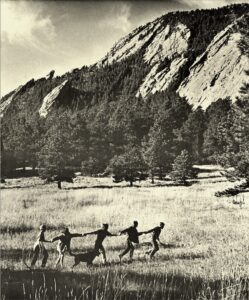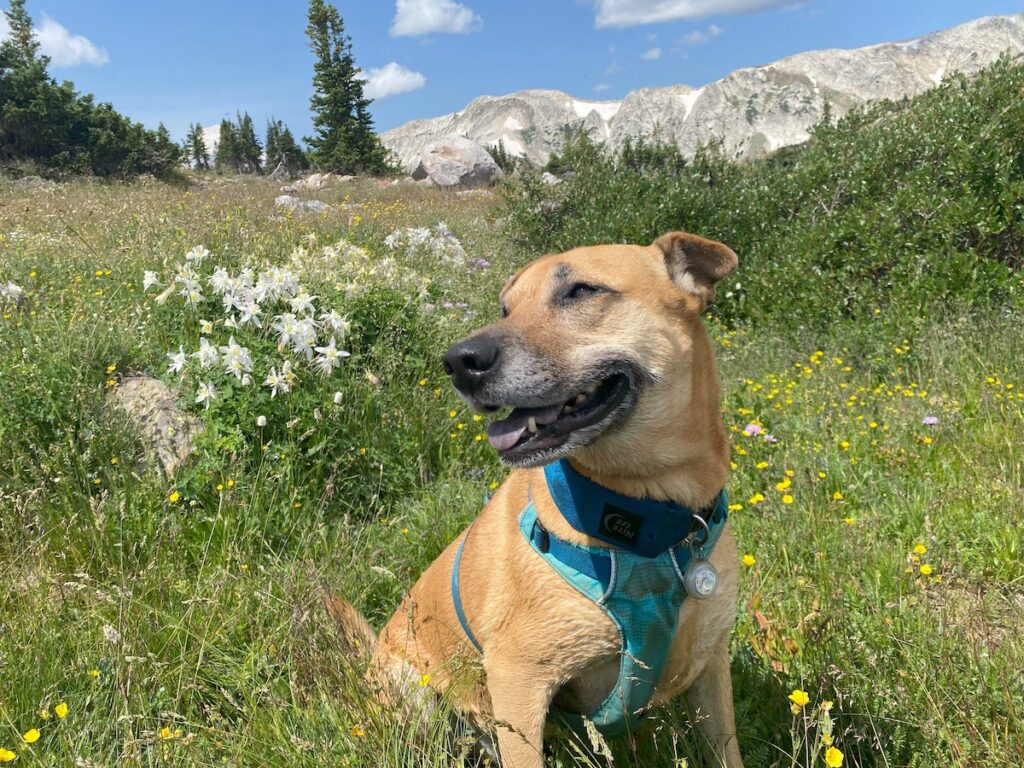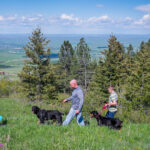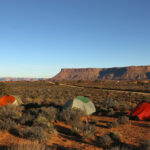Managing off-leash dogs on public trails
By Sabrina White
“Boulder, as a town, has always been super supportive of dogs and people recreating together off-leash,” says Lisa Gonҫalo, recreation management coordinator for the City of Boulder Open Space and Mountain Parks. “We have a long history. We have pictures from the 1970s of people hiking in Chautauqua Meadow with their pups off-leash.” Today, dogs enrolled in the Boulder County Voice and Sight Program are still legally allowed off leash on certain trails within the county. As public trails get more crowded with off-leash dogs and people, programs such as this are appearing around the country, exploring innovative solutions that let dogs happily run free while also protecting the surrounding environment and other trail users.


According to the American Veterinary Medical Association, 45 percent of all households in the US own a dog, totaling between 83.7 and 88.8 million domesticated dogs in America alone. That’s 10 times the entire population of New York City, and a 30 percent increase over the past 20 years. As these numbers continue to grow, there will undoubtably be more dogs enjoying outdoor spaces with their owners, since dogs require activity every day to stay healthy. Dogs that don’t get a chance to run around can gain weight, suffer from joint problems, or develop behavioral issues like excessive barking or unwanted chewing. While requirements vary, most dogs need between 30 minutes to 2 hours of exercise every day. Many dog owners, like Merav Ben-David, routine skijorer with her two huskies Chilkoot and Elwha, are especially fond of areas that allow dogs to explore off-leash. “There is no replacement for off-leash. Because the dog has to make decisions for themselves,” she says. “They are free to explore smells. I mean, they’re wolves, even these little ones. And their whole communication system is based on scent. And if you’re walking the dog on a leash, they don’t have the freedom to explore all the scents around them.”
~
However, off-leash dogs can cause problems if they disturb trail users, attack other dogs, disturb wildlife, or leave poop behind. Melanie Torres, a graduate student at the University of Wyoming, was dog-sitting a huskie named Summit. She had him on a leash in Medicine Bow National Forest, when three little dogs ran up. The owner yelled the classic “My dogs are friendly,” but Summit was not. This story has a happy ending—the owner ran over and grabbed the dogs before anything bad happened—but it’s not uncommon for similar narratives to have much worse endings. After experiences like this, Torres believes off-leash dogs must have good recall and owners should leash their dogs when they see another dog on leash. “If your dog is not listening or paying attention,” she says, “it ruins the experience for everybody.”
Another problem is when off-leash dogs disturb wildlife, but managers and researchers are still trying to understand the full extent to which they impact wild areas. A 2008 study in the Natural Areas Journal looking at dog presence on Colorado trails, found that prey animals like mule deer and prairie dogs stayed further away from trails with dogs, and bobcat density also decreased in those areas. However, a 2011 study in Conservation Biology found that predators avoided trails in northern California based more on the number of humans present than dogs.
A more stinky concern with increased dogs on trails is poop. The Environmental Protection Agency estimates that a typical dog excretes an average of 274 pounds of waste every year. That’s 12 million tons of dog waste excreted in the US annually. On average, 40 percent of dog owners do not pick up that waste, leaving it on the trail with major impacts on ecological systems. Dog poop can spread bacteria and parasites like roundworm or hookworm to animals or people, and it introduces excess nutrients into soil and waterways leading to harmful algae blooms. While one dog pile probably won’t affect anything, the quantity of dogs using outdoor spaces and trails means it adds up. Dog waste collected in plastic bags also adds loads of plastic and poop to landfills.
~
To address these issues, trail managers seek innovative solutions to create a culture of responsibility with dog owners, reward good behavior, and foster a sense of community. The Boulder County Voice and Sight Program is attempting to do just that. Dog owners must watch an hour-long video detailing the natural history of the open spaces and their responsibilities to control their dogs and conserve the area, and their dogs must have a rabies vaccination and dog license. The program requires participants to keep off-leash dogs within sight and under voice control at all times, to clean up after them, and to make sure they don’t chase wildlife. Failure to follow any of the rules results in fines or citations. The City of Boulder Open Space and Mountain Parks surveys currently show 84 percent compliance, so while not everyone obeys, negative events are relatively infrequent.
To prepare dogs for such programs, many dog training companies around the country now offer classes for off-leash specific skills such as ignoring wildlife, recalling when there are lots of distractions, and off-leash heel. Mandy Kauffman, co-owner of Rockin’ E Dog Training and Consulting in Laramie, Wyoming, says, “Before a dog is ready to go out on trails outside, I think they need to have some, at least basic obedience training so that they and their handler can communicate with each other.” She emphasizes the importance of being prepared, ensuring your dog has good recall, and anticipating the types of users or wildlife you might see on the trail. “If a dog is going to be going off-leash on trails, I think that that ramps up a notch,” she says.
Effective off-leash dog programs also strive to prevent wildlife disturbances. During surveys to evaluate the effectiveness of the Boulder County Voice and Sight Program, Gonҫalo found few negative encounters. “The incidence that they observed a dog chasing wildlife was barely reportable. So, of the hundreds of observations, it was maybe a handful, like three to five, so … very small.” Other areas close trails at specific times of the year, such as during breeding or fawning seasons, when wildlife is particularly sensitive. Such regulations must vary for each trail to address sensitive local wildlife species while still allowing responsible recreation.

Addressing the poop problem especially requires creating a culture of responsibility. The City of Boulder Open Space and Mountain Parks holds events to explain concerns with excess poop and increase visibility of the problem. Recently, they organized a cleanup of their four most frequented trails. Staff and volunteers placed flags everywhere they found a pile of uncollected poop. One of their most popular trails, Dry Creek, had 250 flags within the first quarter mile, providing a striking visual for the amount of waste. “[We were] trying to raise awareness around [dog waste],” Gonҫalo said. “The dog owners that came on Saturday were also horrified about what they saw.”
While removing dog waste prevents contamination, what happens to it after is also an important environmental consideration. Fifteen years ago Rose Seemann, co-founder of the non-profit Enviro Pet Waste Network, noticed this smelly issue and wanted to do something about it. Inspired by a USDA study that composted waste from Alaskan sled dogs, she created EnviroWagg and began composting waste from dog parks. After years of successfully creating safe and high-quality compost from dog waste, EnviroWagg now collects from more than 20 Boulder Open Space and Mountain Parks trailheads. “I want to try to get across to composters that this is not nuclear waste, your compost pile is not going to blow up, you’re not going to poison people. If you compost it with everything else, it will be fine,” Seemann explains. “You just have to have all these things in place. You have to teach people not to use plastic.” Proceeds from EnviroWagg support the Enviro Pet Waste Network, which teaches people alternative ways to deal with pet waste and keep plastic and poop out of landfills.
~
Off-leash dogs using public trails don’t have to harm other users’ experiences or the ecosystem. Programs like Boulder County Voice and Sight are spearheading sustainable practices and creating a culture of responsibility that allows dogs to explore to their hearts content while minimizing their impact on the environment and people. “In Boulder, I think we kind of consider pets our children and that’s how we advocate for them,” Gonҫalo says. “And so, letting them experience the outdoors and sniffing and doing all the things that dogs love to do is a wonderful opportunity for that.”
Sabrina White is a graduate student at the University of Wyoming studying bumble bee thermal tolerance in Michael Dillon’s insect ecophysiology lab. She is also a dog parent to Slack and Bear.
Header image: A man walks with an off-leash dog on a public trail. Courtesy City of Boulder Open Space and Mountain Parks.


